The goal of parenting is to equip your kids with the skills and values needed for them to be independently successful in life. One of the reasons we love homeschooling is that we can instill these crucial skills in our kids at an early age so they can have a comprehensive understanding of how the real world operates. And what is the one thing we must do week in and week out, day after day, regardless of age? Eat! And thusly shop!
Enter the grocery store preschool learning unit! I have had such fun thinking up ways to incorporate the every-day chore of grocery shopping into a learning unit for my kids. It was very simple to structure the dramatic play center, and everything in my corresponding unit printables just fell right into place!
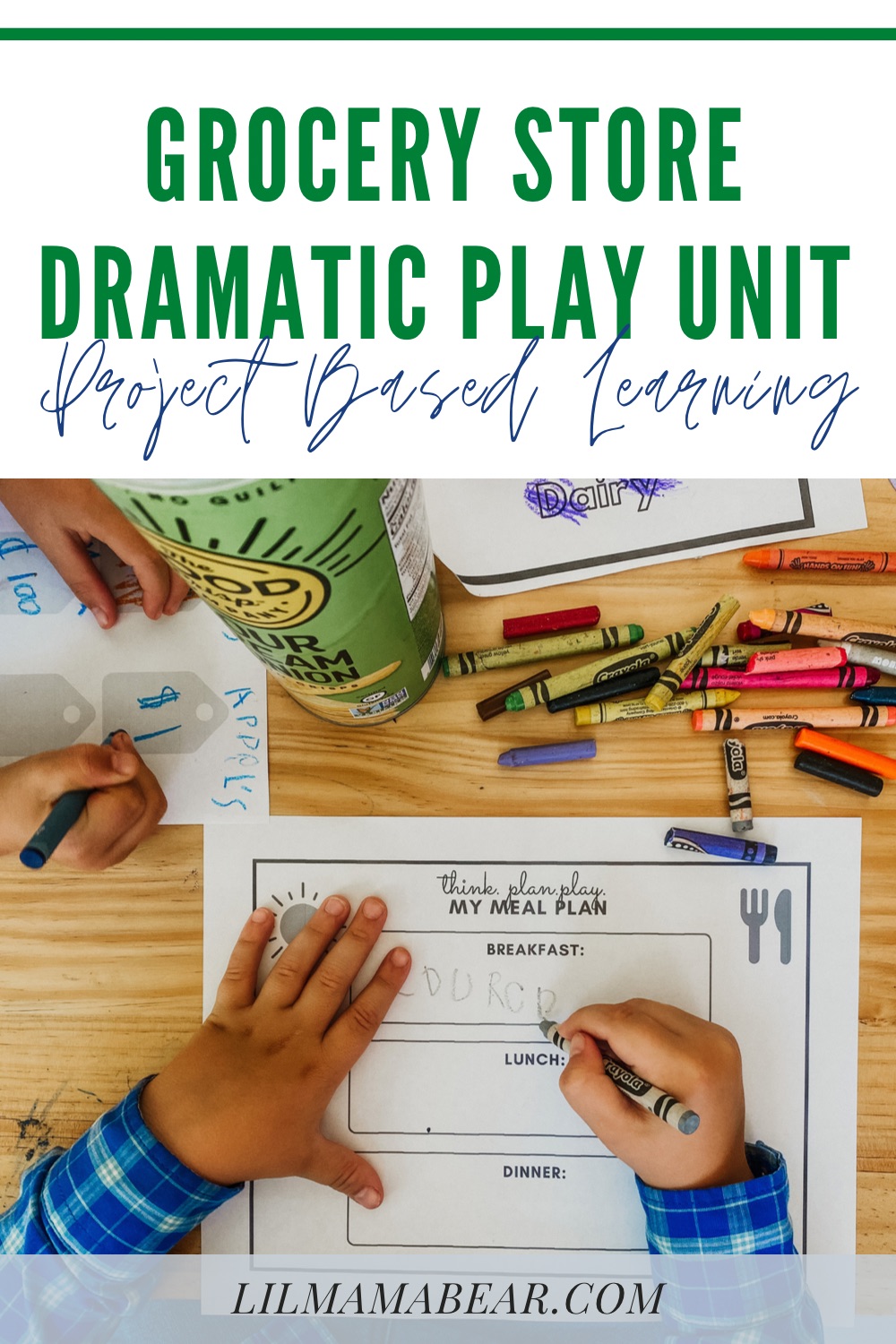
What is the advantage of using project-based learning units?
In my post describing the Post Office PBL Unit, I explained the PBL. Essentially, it is a series of activities, lessons, and assignments that combine to create a single product while laying the groundwork for a more comprehensive understanding of the topic along the way. In the post office unit, our “culminating event” was the post office dramatic play. In this unit, the student(s) construct their own grocery store!
The advantages of using this methodology for learning is that it gives the students a real-world frame of reference as the various concepts are explored. For instance, a teacher might introduce a lesson on money and tell the students that the value of a dollar is four quarters. How much more impact would it have on the students if instead, they are instructed to “purchase” their own items at a cashier’s desk using play quarters? Kids learn by doing, and project-based learning provides exactly that opportunity!
Teaching the same content to multiple grade levels
In my case, I have a 5 year old going into 1st grade and a 2 year old going into pre-preschool. Also an infant, but that’s beside the point.
Teaching this range of age levels might sound daunting, and yes let’s be honest at times it is difficult, but with project-based learning it really is quite simple! The content remains the same for everyone, the only variable is the level of development required for the assignments and activities. In some cases, I will adapt the instructions to meet the level of my 2 year old, and in other cases the project itself naturally allows room for my 5 year old to soar in her abilities by simply letting her follow her interests and ideas! This will be explained more in-depth with each assignment below.
I might add that while I have titled this a “Preschool” learning unit, it by no means is confined to pre-kindergarten. As I said, my daughter is going into 1st grade, and she had a blast with this project! Preschool is a great place to start, but I could see this project being adapted to suit up to 6th graders!
Grocery Story Project-Based Learning Unit
In my printable packet, there is an assortment of printables to use in constructing the dramatic play center as well as games and activities to use supplementally.
Inside the unit packet:
- Name Tags (page 3)
- Debit Cards (page 4)
- Grocery Store Matching Game (page 5)
- Shopping Cart Game (pages 6-8)
- Vocabulary Words (pages 9-10)
- Name That Price (pages 11-12)
- Aisle Labels (pages 13-14)
- Open/Closed Sign (pages 15-16)
- Shopping Lists (pages 17-18)
- Receipts (pages 19-20)
- Meal Plans (pages 21-22)
- Piggy Bank Activity (pages 23-24)
- Money and Price Tags (pages 25-32)
- Rainbow Food Matching Game (pages 33-34)
You can also grab the free lesson plans here!
Lesson Plans
The lesson plans I have provided for freeeee is by no means an instruction manual. If you don’t place A and B together at a 90 degree angle, the learning unit can still be a roaring success! In fact, another beautiful thing about the project based learning unit is that there is no wrong way to carry it out!
If you are looking for some guidance, however, I have put together this week-long unit plan. Personally, I would stretch this out for about a month, delving deeper into the topic with more hands-on experience and several trips to the actual grocery store (for “research” 😉 ), but it could definitely be done in a week. The lesson plans are designed for ages 4-6 years old, but as I said above, this can be changed to meet the needs of nearly any elementary-level student.
All you need to carry out this grocery store preschool learning unit with ease are the lesson plans and the unit printables! There, you will find materials lists, links to YouTube playlists, books to acquire, learning objectives, lesson flow, and so. much. more!

Printable Contents
Name Tags
These were one of my favorite components of the Post Office Unit as well. Print them out, glue a tiny photo of the student’s face, and have him/her write his/her name before laminating it, cutting it out, and sliding it inside a 3” x 3” plastic name tag holder attached to a lanyard. Voila! You have a legitimate grocery store employee.
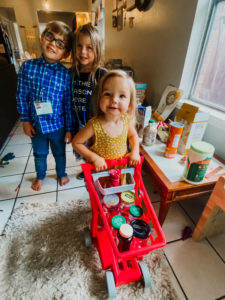
Debit Cards
Paper money and coins are the focus in the elementary school classroom, but be honest – when is the last time you used cash to buy something? Kids need to understand that the piece of plastic Mom and Dad swipe, insert, or tap on the little card terminal isn’t a magic wand. It’s connected to an actual bank account with an actual balance. This partnered with the Piggy Bank game explained below gets students a little closer to understanding the abstract concept of digit payment.
 Shopping Cart Game
Shopping Cart Game
A mini-version of what you are trying to construct, the Shopping Cart Game gives students a taste of shopping based upon a list, with the added flare of the check box.
If you don’t understand how fun a checkbox is to a child, then you have not been around children very often.
 You’ll need:
You’ll need:
-A laminator
-A pair of scissors
-A dry erase marker
(if you don’t have a laminator, this game can be played once per page)
Instructions:
- Before the lesson, cut out the shopping cart page, the corresponding food cards, and the vocabulary words. Laminate.
- Cut out the food cards.
- Teacher or students can lay out the vocabulary words then sort the food cards to match each sign. These are the “aisles”.
- To play, students will look at the food options (vocabulary words) and decide how many of each item they want to purchase (don’t go above 10). The students will then write the item and the desired number on a line. For example, “5 eggs”.
- The students complete the “shopping list”.
- “Go shopping” by placing the correct number of each item on the shopping cart image. After each is selected, check the corresponding box.
- Continue until all items are shopped.
Variation: This can be done in pairs, as a center activity, with a group, or on a timer for an added challenge!
Name That Price Game
In the lesson plan, this is recommended to be played using real dimes or the 10 cent cut-outs from the unit printables. Laminate and cut out each card, then place the correct value of money in the space below the item. This is great practice for counting by 10’s!
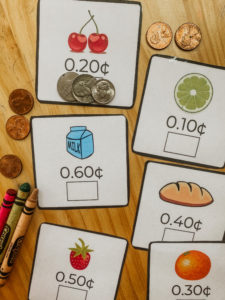
Meal Plans
Two types are provided in the printable packet: a weekly meal plan and “My Meal Plan” which includes space for a single day. I recommend using the latter for a week-long unit study as the other might be overwhelming to young students.
When we did this activity, we had already collected the items for the grocery store, so the kids could take packages and write whatever they wanted on them. Pictured, Genny’s neighbor friend decided he wanted potato chips for breakfast. No problem! It was great handwriting practice for him copying the letters.
The week-long meal plan would be an excellent tangent route for slightly older students – about 6 years and up. It requires more thought and familiarity with different meals. This concept is a goldmine of practical lesson ideas though, and it could be expanded to include cooking and baking, etiquette, table-setting…gahhhh the possibilities are endless!
 Piggy Bank Activity
Piggy Bank Activity
Another potential rabbit-hole activity, the Piggy Bank in the printables can be expounded to be an additional “banking” component of the grocery store play center if desired, but only if you’re planning to stretch the project out for a couple of weeks.
 The goal of this activity is to teach the concept of a bank account. The sheet with a decimal point on the blank is for older students who understand what that means. For younger students, I’m talking 3 or 4 years old, just use coins and have them count the number of coins rather than add the value. Laminate each page, then give students a specific amount of money (more for young students, less for older students). Using a dry erase marker, have students write the amount of money on the blank.
The goal of this activity is to teach the concept of a bank account. The sheet with a decimal point on the blank is for older students who understand what that means. For younger students, I’m talking 3 or 4 years old, just use coins and have them count the number of coins rather than add the value. Laminate each page, then give students a specific amount of money (more for young students, less for older students). Using a dry erase marker, have students write the amount of money on the blank.
You can then go from here to have students add to or take away from their “bank accounts”, using correct verbiage such as “withdrawal”, “deposit”, and even “transaction”! Kids love to know the correct words for things.

Rainbow Food Matching Game
Use this as a simple matching game for Littles and a Go-Fish variation for Bigs! We used the phrase “Go shopping!” instead of “fish”.
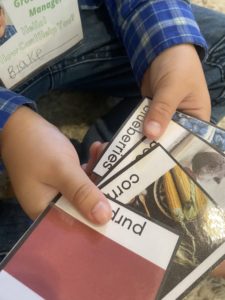 Money, Price Tags, Aisle Labels, Shopping List, and Receipts
Money, Price Tags, Aisle Labels, Shopping List, and Receipts
There are the funnest aspect of the unit, in this Mama’s opinion! The money is recommended to be printed on cardstock, then have students draw the faces of the correct president in the center space. Each “bill” has the president’s name written below the space – just like real money!
 Decorate the aisle labels and laminate for extended use. I recommend the laminate nearly everything! haha
Decorate the aisle labels and laminate for extended use. I recommend the laminate nearly everything! haha
The price tags, shopping lists, and receipts are extra elements to bring dramatic play to life!

 Open/Closed Sign
Open/Closed Sign
Instructions for putting together the Open/Closed Sign are included in the lesson plans as well as below.
You’ll need:
-a laminator
-a pair of scissors
-a brass fastener
-a hole puncher
-string
Instructions:
- Print each page on a separate paper
- Laminate them back-to-back
- Cut along the bottom of both papers so there is an opening between them
- Cut out the clock hands and stake them on the brass fastener
- Carefully poke the brass fastener through the center of the clock and fasten between the two sheets
- Use hole puncher and string to hang sign.

Dramatic Play Center
And now, the moment you’ve all been waiting for…… *drumroll* Time to play in the dramatic play center!!
If you’re confused by this term, it’s just a verbose, teachery way of saying “a space for kids to play”.
Now, why wait until the end of the week to actually play? You might ask. In my personal experience with my children, you can have the absolutely coolest project product in the world….and they play with it for half an hour and then they’re bored. When the play center is the climax to a week of imagining, planning, creating, brainstorming, and crafting, even the littlest ones will feel more pride and satisfaction in their play.
Of course they still might only want to engage for half an hour, but you don’t feel as bad when it’s time to scrap the project because the value wasn’t just in the goal, it was in the journey.
Materials Needed
The construction of this play center is simple, only requiring surfaces upon which to place things. Collect boxes, containers, cartons, and bags from the kitchen for a period of time, making sure to rinse any food particles and letting things dry before setting them aside. If you want to go the extra mile, you can provide markers, paint, glue, popsicle sticks, construction paper, and other art supplies to have students remake the food that goes in the containers. Another option is to superglue lids on, bags closed, and boxes sealed!

We also threw in some empty grocery sacks and an H-E-B play shopping cart that the girls already had (thanks to my mom). You can also put in a kitchen scale if you want to really complete your produce section.
Genny also had the idea of creating coupons! So she grabbed a sheet of drawing paper, wrote some out, then taped them next to the item they were for. It was adorable!

I hope this post inspired you to pursue your own project-based learning unit! Also known as just walking your kids through life. 🙂 Comment below to share with me your lesson ideas!
Love, Emily XOXO




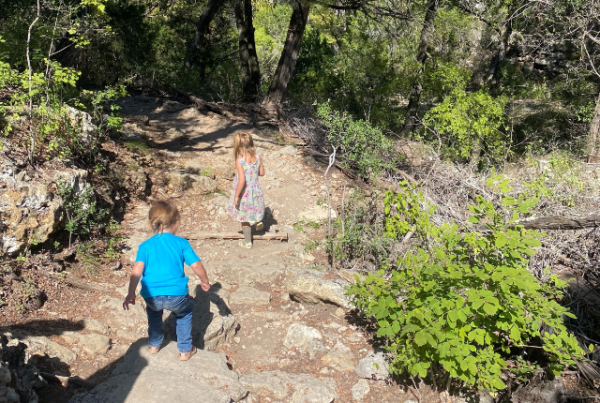


What People Are Saying